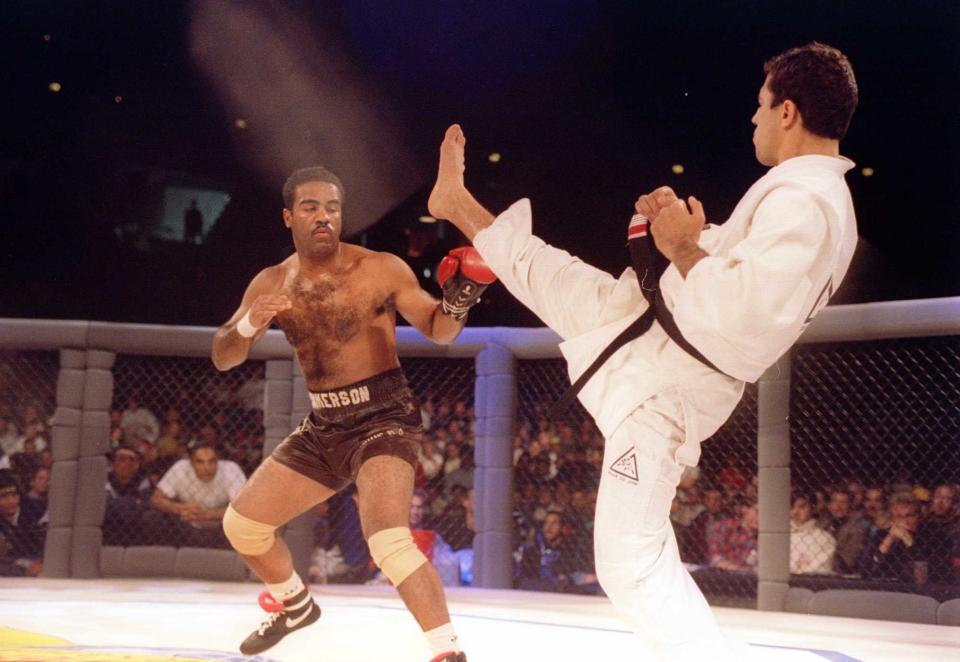The UFC at 25: Where the company stands now and what to expect in its second 25 years

When Jon Jones debuted in the UFC in 2008, there had never been an athlete like him in all of mixed martial arts. He had the long, lean body of an NFL wide receiver or an NBA guard, but he had an instinctive feel for fighting that one can’t get by watching videos on YouTube.
Of course, Jones did watch YouTube videos in his early days in the UFC to learn moves he’d then try in the Octagon.
Jones was a sign of things to come, the future of what mixed martial arts would be. He wasn’t a burly wrestler who could learn how to throw powerful punches. He was a wrestler, but he was far more than that an athlete with size, speed, grace, agility and an uncanny sense of time and space.
He fought Stephan Bonnar at UFC 94 and Bonnar remarked at the time how even when he had a great distance between himself and Jones and felt safe, Jones could close that distance with one step.
Jones was a sign of what MMA fans could expect as the sport developed, as paydays increased and the sport’s notoriety skyrocketed. In the mid-2000s, kids could legitimately dream of a career as an MMA fighter and not just as a baseball, football or basketball player.
Prior to Jones, a large number of athletes went into MMA after finishing their careers in other sports, and used MMA as a way to make money before it was time to retire.
Since Jones — and really, since the success of Season 1 of the reality show, “The Ultimate Fighter,” — athletes could realistically choose MMA as a career option because there was enough money in it, even if most of it was at the top.
The UFC’s official 25th anniversary is on Monday, but it will celebrate on Saturday at the Pepsi Center in Denver with a compelling card headlined by Yair Rodriguez against “The Korean Zombie,” Chan Sung Jung.
Jones stands as the greatest fighter of those first 25 years, for his victories over the likes of Daniel Cormier, Alexander Gustafsson, Rashad Evans, Lyoto Machida, Vitor Belfort, Rampage Jackson, Shogun Rua and Ryan Bader, among others.
The next 25 years won’t see such a dramatic uptick in talent from the first year to the last, like it did in the UFC’s first 25 years, but who could have ever imagined an elite athlete like Jones on Nov. 12, 1993? One fighter that night wore one boxing glove. Another weighed 420, 155 pounds over what is the limit for heavyweights now and more than 200 pounds more than the eventual winner that night, Royce Gracie.

Not one of the eight fights that night went more than four minutes, 20 seconds. The total fight time for all fights on the card was 13 minutes, 25 seconds.
The quality of athletes and the quality of the fighting will improve, however. While the UFC has been around for 25 years, it was finding its way in the early days and so it’s probably fair to say that in its current incarnation, it’s only been about 18 years old.
The UFC has the best roster it has ever had, even after it has lost elite talents like Demetrious Johnson and Eddie Alvarez to rival ONE FC.
Out of that group is going to come someone who will surpass Jones as the standard for what a mixed martial artist should be.
That fighter could already be on the roster, or it could be someone who hasn’t turned professional yet.
History tells us that the quality of athletes in all major sports improves over time as technique, training, better scouting and more opportunity combine to push it forward.
In 1969, the Pittsburgh Steelers drafted defensive tackle Joe Greene in the first round, fourth overall. Even though a Pittsburgh newspaper asked, “Joe Who?” on the day he was drafted, it was a prudent pick. Greene went on to become one of the greatest players in NFL history and a catalyst for the Steelers’ four Super Bowl victories in six years in the 1970s.
It’s safe to say that Greene is one of the three or four best defensive tackles in NFL history. He was massive for his time, at 6-foot-4 and 275 pounds.
Today, though, the Steelers have a linebacker, Bud Dupree, who is 6-4, 269 and who runs a 4.5 second 40-yard dash. If the 275-pound Greene played against the Steelers’ offensive line today, he’d be facing guys who are 6-9, 320; 6-5, 328; 6-4, 304; 6-5, 316; and 6-6, 330.
MMA fans can look forward to a future with more skillful, better trained and better coached athletes. Coaching will be a huge part of the sport’s second quarter-century. In the early days of MMA, the coaches were learning as they went along and in some cases, didn’t know as much as their fighters.
But in the UFC’s second 25 years, the number of elite coaches will blossom and that will lead to better athletes more prepared for battle.
As great as these first 25 years have been, know this: You ain’t seen nothing yet.
More from Yahoo Sports:
• NFL Power Rankings: Who’s No. 1 now?
• USOC moves to revoke USA Gymnastics’ status
• Pat Forde: Alabama’s a juggernaut, but one team can match it
• Charles Robinson: Bell, Steelers can create a win-win situation

 Yahoo Sports
Yahoo Sports 
